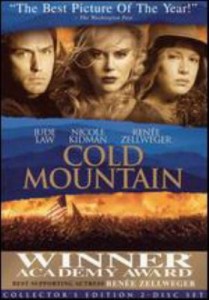 North Carolina has been a popular setting for movies and television shows, yet that setting is most often fictitious. Of the 600 movies and shows nominally sited in North Carolina between 1980 and 2002, 95 percent were actually filmed outside of the state. Anthony Minghella’s adaptation of Cold Mountain was one of them. Charles Frazier’s novel depicts Confederate deserter W.P. Inman’s long and arduous journey from a hospital in Raleigh to his home near Cold Mountain and his sweetheart, the genteel Ada Monroe from Charleston, who struggles to survive on her own following the death of her father. British director Anthony Minghella scouted locations over a period of five years before deciding to film the adaptation in Romania. Filming in North Carolina would have been a boon to state tourism. When the novel was released in 1997, it created a small increase in tourism. Local businesses and state officials knew that filming here would both make jobs and increase tourism.
North Carolina has been a popular setting for movies and television shows, yet that setting is most often fictitious. Of the 600 movies and shows nominally sited in North Carolina between 1980 and 2002, 95 percent were actually filmed outside of the state. Anthony Minghella’s adaptation of Cold Mountain was one of them. Charles Frazier’s novel depicts Confederate deserter W.P. Inman’s long and arduous journey from a hospital in Raleigh to his home near Cold Mountain and his sweetheart, the genteel Ada Monroe from Charleston, who struggles to survive on her own following the death of her father. British director Anthony Minghella scouted locations over a period of five years before deciding to film the adaptation in Romania. Filming in North Carolina would have been a boon to state tourism. When the novel was released in 1997, it created a small increase in tourism. Local businesses and state officials knew that filming here would both make jobs and increase tourism.
Romania was a more attractive choice to Minghella because the rural landscape is much more intact than in North Carolina, where elements of modern life, like telephone poles and paved roads, are present, and logging has altered the area’s appearance. Minghella also noted that there were too few period buildings around Asheville and its environs. By contrast, Minghella could more easily manipulate the Romanian countryside to look like Civil War era North Carolina. The majority of the film was shot in Romania, though a few locations in North Carolina, South Carolina, and Virginia were used.
The real Cold Mountain at its highest point is a daunting 6,030 feet. The mountain is located within the Pisgah National Forest. Asheville’s tourism site advises that only experienced hikers should dare to take on 11-mile hike, which has no trail markers. Visitors can view the mountain from the Blue Ridge Parkway.
Inman, Frazier’s protagonist is based on relatives–chiefly his great-great-uncle, but also his great-grandfather. Frazier retrieved information about Inman’s service from the North Carolina State Archives, whose records state that Inman deserted twice, although conflicting records throw doubt on the second desertion. Inman’s neck injury sustained during the Battle of the Crater and his death at the hands of the Home Guard are verified facts, represented in the novel and the movie adaptation.
Overall, the movie, featuring Hollywood stars Jude Law, Nicole Kidman, and Renée Zellweger, is faithful to the book in terms of plot, though there are differences in mood. The romance between Ada and Inman and the violence (specifically the brutality of the Home Guard) are accentuated on-screen. Most of the characters are appropriately scruffy and disheveled, given the tough conditions, but Charles McGrath of the New York Times notes that Kidman’s Ada Monroe remains improbably radiant throughout the film.
Treatment of race and slavery drew some critical remarks. Both the book and movie’s portrayal of the Battle of the Crater downplayed the important presence of black soldiers on the Union side. Brendan Wolfe made a counterpoint during a critique of the first chapter of Kevin Lenin’s Remembering the Battle of the Crater: War as Murder. Wolfe is not troubled by how the novel and the film skirt around these tense issues since the focus of the story is not strict historical accuracy or a panoramic view of the war. Cold Mountain is the story of a disillusioned man on an epic trek home that parallels The Odyssey. But race and slavery are difficult topics to broach, and the representation of the American South throughout film history is varied.
Minghella’s Cold Mountain was recognized with over 70 awards following its release in 2003. Renée Zellweger won Best Supporting Actress at the Academy Awards, and the film was nominated for Best Actor, Best Cinematography, Best Editing, Best Original Score, and Best Original Song twice: for T-Bone Burnett and Elvis Costello’s The Scarlet Tide and Sting’s You Will Be My Ain True Love. For those interested in the music of the film and Appalachian folk songs, look at this interview of Charles Frazier in the Journal of Southern Religion. Cold Mountain was the seventh film directed by director-producer-screenwriter-actor Minghella who died in 2008. The movie is available through the UNC-Chapel Hill Library catalog, as is the novel. The original blog post on Frazier’s novel is available here.
Sources consulted here: Augusta Chronicle, Book Browse, Chicago Times (two different articles), Encyclopedia Virginia, Explore Asheville, History Extra (of BBC History Magazine), Journal of Southern Religion, Los Angeles Times, Movie Clips, New York Times, Prologue Magazine (of NARA), USA Today, Wikipedia (Anthony Minghella, Cold Mountain [film], Cold Mountain [novel], Cold Mountain [North Carolina])

